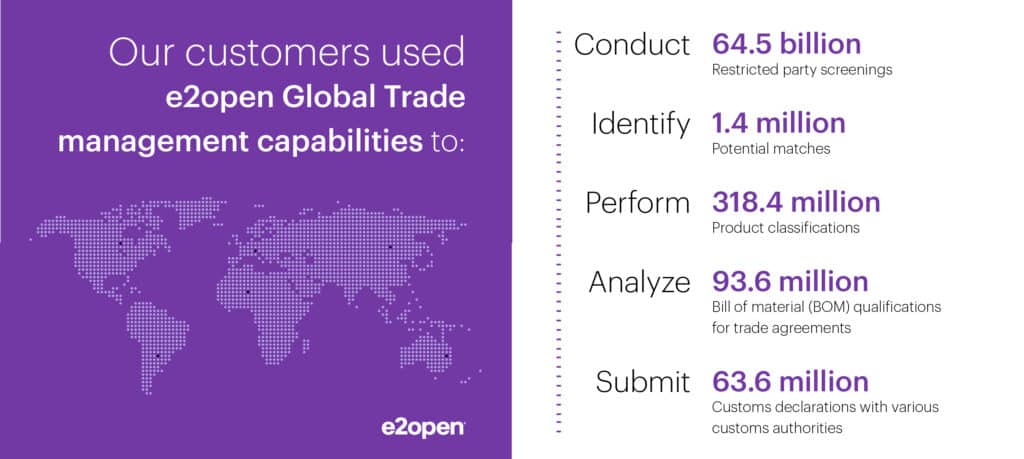
As the new year rolls in, it is a perfect time to reflect on the trends that shaped the global trade landscape during the last 12 months. The benefit of hindsight is that it gives us an idea of how some of these trends can be baked into our supply chain strategies and global trade management (GTM) plans going forward. At e2open, we are proud to have responded effectively in 2023 to position our customers to better prepare for the new year and beyond.
Several trends solidified in 2023, many of which had undercurrents already in play from years prior, leading to major shifts in global trade flows and compliance landscape. In this blog, we will briefly discuss the key trends that will have broader implications for businesses in the new year and beyond.
Geopolitical tensions
Geopolitical tensions in many parts of the world continue to make a significant impact on global commerce and trade. For instance, escalating trade tensions between the US and China, as well as ongoing conflicts in Eastern Europe and the Middle East, have led to the implementation of stricter export control and sanctions regimes. Just in the last few weeks of 2023, the Red Sea, a critical conduit for global shipping, became the focal point of tensions with militant attacks on ships traversing this region, raising concerns over potential disruptions to global trade. In order to mitigate risks from these ongoing tensions, businesses may need to reevaluate their supply chain strategies, consider new sourcing regions, and navigate different borders to move their goods effectively.
Rise of Regional Trade Agreements (RTAs)
According to the World Trade Organization (WTO), 360 Regional Trade Agreements (RTAs) are in force as of August 2023, covering more than half of global trade. Many RTAs were concluded or entered into force with additional member countries and became fully operational in 2023. According to a recent Harvard Business Review article, the world is shifting from a global trade order to a devolved one in which bilateral agreements, multiple spheres of influence, and self-interested government policies are likely to loom large. In response, organizations should prepare to leverage technology to collaborate across all tiers of the supply chain.
Digital transformation
Digital transformation reached a crucial stage in 2023 for GTM. Several customs modernization efforts took effect this year within many jurisdictions, such as the Import Control System 2 (ICS2) in the EU, the Automated Tariff and Local Customs Clearance System (ATLAS) in Germany, and the Declaration Service (CDS) in the UK. These efforts will have huge impacts on participants in the global supply chain. Another major influence came from the Artificial Intelligence (AI) use case implementations going mainstream and the potential benefits of generative AI as the boardroom topic of the year, contributing to more technology investments from businesses and governments.
Sustainability and social responsibility
Lastly, the growing awareness and urgency of addressing environmental sustainability and social responsibility issues in the face of the climate crisis and labor issues came to the forefront in 2023. Increased enforcement of forced labor laws in many parts of the world, taxes on non-recycled plastic packaging waste in the EU, and stricter greenhouse gas (GHG) reporting requirements in California are just a few examples that called for more attention from global trade and compliance professionals during the year. This is an area where businesses will continue to invest more as increased regulations and enforcement actions occur in the coming years.
Looking ahead
The digital transformation of GTM will continue to accelerate this year as businesses and governments seek to leverage the benefits of digital technologies and AI solutions to enhance their competitiveness, resilience, and agility in cross-border operations. The increasing demand from customers, suppliers, regulators, and society for more transparency, traceability, and accountability will drive the adoption of digital technologies and solutions. However, the digital transformation of GTM will also pose new challenges and risks, such as data privacy, cybersecurity, interoperability, standardization, and regulation. Therefore, businesses must invest in developing their digital capabilities, infrastructure, and governance frameworks to ensure their GTM processes are secure, compliant, and ethical.
Are you ready to stay ahead of the competition?
With the rapidly shifting global trade landscape, businesses must be proactive and ready to adapt to keep up with the latest trends and developments. Fortunately, e2open is here to help. As the leader in the connected supply chain platform and the GTM solution landscape, e2open is committed to helping its clients navigate the complexities of global trade and enable them to achieve their strategic objectives as part of their digital transformation journey.
In the last year, our trade content experts maintained our proprietary database, Global Knowledge®, by making more than 72 million regulatory content updates. But the staggering numbers for 2023 don’t stop there. The statistics highlighted in the graphic below speak for themselves about the value of our connected Global Trade Management solution:

Don’t let the challenges of GTM hold you back. Contact e2open today to learn more about our leading-edge solution and how it can help you stay ahead of the game in the fast-evolving global trade landscape. With e2open, you can be confident that you are prepared for the future!







